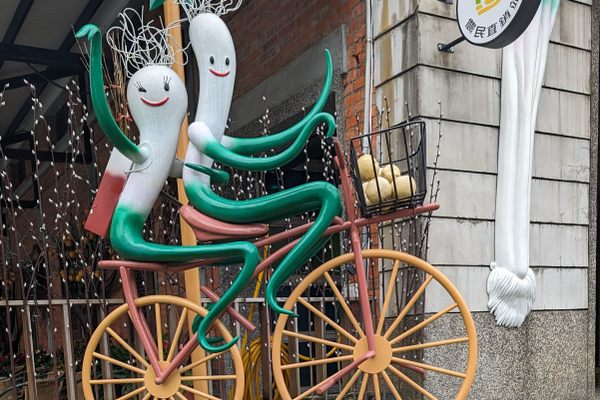
At Sea on Taiwan’s Last Fire-Fishing Boats
Generations of nocturnal fishermen have lured their catch with fire.
It’s pitch black on Taiwan’s waters, and in a few minutes, all hell will break loose. A boom and blaze of fire explode into the night sky, followed by the sour stench of sulphur. Thousands of tiny, ray-finned sardines suddenly leap out of the Pacific Ocean—in a wild, graceless dance—hurling themselves toward the scorching flames. Meanwhile, fishermen work feverishly to scoop them up, before they plunge back into the sea. The scene is utter chaos.
Traditional sulphuric fire fishing is a century-plus-old practice found only in Jinshan, a sleepy port city near the northern tip of Taiwan. Fishermen use a bamboo torch and soft sulphuric rocks to ignite a fire fierce enough to drive hordes of silver-scaled sardines to the water’s surface. And the golden hour for making fish fly? Set sail during a “moonless night,” when the sun has long dipped below the horizon and the fish are starving for light, says 71-year-old Ketong Lee, a boat captain who’s been fire fishing for more than half a century.
Sulphur is one of Jinshan’s most abundant natural resources, found everywhere from the village’s rocky golden cliffs to its murky-colored hot springs. Each fire-fishing boat carries a metal cauldron full of these dusty sulphuric rocks, which produce flammable gas that is fed into a long, skinny bamboo rod affixed to the boat’s rear. In a process known poetically as “phototaxis,” the fire’s blinding brightness “attracts the fish so fervently that they leap out of the water towards the smoldering light,” says Yushan Han, a professor at the National Taiwan University Institute of Fisheries Science.

Moreover, nothing is measured. The fishermen know everything by heart: how much sulphur to use and for how long. But there’s no room for mistakes, warns Lee. “Fire fishing can be dangerous,” he says. If the fire lingers too long, the boat and everyone onboard could explode.

The fishermen rise from their slumber just as the oven-hot sun dips below the horizon. This is when the grind begins. Their work won’t end until the sun’s morning glow appears again and birdsong fills the air. In the small city of Jinshan, the glitz of Taipei’s skyscrapers fade into the craggy coastline and steep mountain passes that spit out into the dead-quiet Huangguang Fishing Harbor. It’s the beginning of the fire-fishing season, which will last from May to August, when sardines migrate south from Japan to Taiwan’s northern shores.
After slurping down a bowl of rice flour noodles, the crew of eight prepares the traditional boat, a dazzling collage of earthy red, green, and blue colors. A clunky pair of wet boots and yesterday’s laundry still hang from the side—the fishermen spend most of their waking hours on the boat. “Whether or not the fish is caught is decided by the gods,” says 56-year-old fire fisherman Zhiyang Xie. He sees fire fishing as a higher calling, with an overwhelming “sense of mission.”

At the helm of the boat, Captain Lee barks orders. He’s the oldest among them. Like a conductor, Lee directs the men and sets the rhythm. Each fisherman has his own part, his small beat in the larger melody. Fasten the ropes. Fill the tanks. Load the ice buckets. “You can’t make a fire on your own. That’s the difficulty in fire fishing,” says Xie. “You must rely on a lot of people to work together: Someone to man the fire, someone to draw the nets, and someone to steer the boat. If you lack one, it will be hard.”
These fishermen describe sulphuric fire fishing as not just a way of life, but also a sacred form of art, indelibly linked with the place in which they were born and raised. Captain Lee, like the others, wields decades of experience that’s been passed down from generation to generation, from father to son. “It’s a lot like learning math,” he says, taking a small breather before grabbing another load of ice for the boat. Once you get the hang of things, the formulas, the rules, everything else just falls into place. On a good night, the fishermen can catch hundreds of barrels of fish, up to three tons of sardines per boat, which can rake in as much as $4,500. But that’s just a tiny fraction of the larger fishing industry in Taiwan, says Han. Each kilogram sells for a mere 33 cents, peanuts compared to the value of more popular fish species. Some days, the fish don’t even bite. “If you go out to sea everyday and don’t catch fish, there’s really nothing you can do about it. That’s just fate,” says Xie.
As the evening sky unfolds, the fishermen heave up anchor and set sail at high tide. They suck on cigarettes and wait for the swarm of fish to arrive. But on the horizon, storm clouds start to roll in.

In its glory days, this painstaking practice was used by thousands of fishermen all across the lush islands of Taiwan. The technique was first developed by the Pingpu aboriginal tribe, according to local guides and a local cultural bureau, and honed during Japanese colonial rule in Taiwan more than 100 years ago. Now, there are only four fire-fishing boats left and a dwindling number of fire fishermen.
Young people are unwilling to continue such a backbreaking tradition. The remaining fire-fishing boats are rickety and the equipment is rusted. Not to mention, says Lee, “the work is exhausting, the pay is unstable, and the reward is low,” especially compared to the sleek, more modern commercial-fishing ships that use electric light bulbs to attract fish. Most of his fellow fishermen are already in their 50s and 60s. As he leans on the boat’s edge, he struggles to speak Mandarin Chinese, the dominant national language. So he instead settles for his mother tongue, Taiwanese Hokkien, a local dialect that’s less common these days in northern Taiwan, just like his chosen trade. “We don’t want to part with this tradition, so we begrudgingly continue,” he says.

A full-blown publicity campaign is underway. To plug the leak in fire fishing, the local government provides a small subsidy to fishermen who elect to use the traditional technique. But according to the local fishermen’s association, the incentive is not nearly enough to make up for the dwindling profitability of fire fishing. A few years ago, the government set up the official Jinshan Sulphuric Fire Fishing Festival in order to raise money, promote the practice, and spread awareness of its decline. Now, every season, large, comfortable sightseeing boats filled with eager tourists and photographers set sail alongside the traditional fire-fishing boats. It’s a chance to see the spectacle up close, and people are taking the bait. A half-day tour package includes a lengthy introduction to the region’s different fishing practices, a modest dinner, and boat fare, with total fees ranging from $45 to $100 per person.
But these efforts, while earnest, are likely still not enough. “If we fail to hand down fire fishing to the next generation and let the practice die out, everything will disappear,” says Xie. “Now it can be said that my generation is the final fire-fishing generation.”

As fat drops of rain start to pour down, a nearby sightseeing boat full of gawking 20-somethings blocks the way of a fire-fishing boat. They cheer the small group of fire fishers on, coaxing them to keep plodding forward. Others pout at the bad weather and swipe at their smartphones. In many ways, the tour is a strange performance. The tourists are the audience while the fishermen are the reluctant actors. Placing these fishermen’s work on a makeshift stage—to be photographed and uploaded to social media—may save their livelihood, but at the potential cost of changing its meaning.
“As the age of the fishermen slowly climbs up, the fire fishing industry might also gradually enter history,” says Professor Sheng-Ping Wang, the chair of National Taiwan Ocean University’s Department of Environmental Biology and Fisheries Science. “Sulphuric fire fishing may be able to be developed or maintained by becoming a cultural tourism industry, but it will no longer be a commercial fishery industry on which fishermen can depend on for their livelihood.”

People are fighting to save this tradition, but others, even some of the most respected fishermen, feel more ambivalent. “If it continues, then it continues,” sighs Lee. “But if it doesn’t continue, then it doesn’t. That’s just life.” Xie feels similarly. “I’d like to say that I want to continue passing on this tradition,” he says, the wrinkles on his face creasing at the corner of his eyes. “But if you can’t really catch fish, this sense of mission will also become empty talk.”
A few years ago, the fire fishing tradition got an official nod from the city government as a “cultural asset” and “national treasure” to be protected by the New Taipei City Cultural Bureau. But ultimately, nothing changed, says Zhengcheng Xu, a tour guide for the fire-fishing sightseeing trips and Jinshan chairman for the New Taipei City Leisure and Tourism Association. “It was just a name, a title,” he adds. The shrinking fire fishing fleet is still facing extinction.

As the sardines start flying, the fishermen ready their small mesh scoop nets. They frantically collect the fish, gingerly placing them on a bed of ice. The cold will keep them fresh until the morning, when the fish markets open at dawn. Tonight, they will toil for another six hours, sailing the darkened seas as the rest of the country sleeps, until their hands are raw and muscles are sore. “People who live off the sea have to accept their fate, to be optimistic, to try to make a living. If they can’t catch fish, there is nothing more to be done,” says Xie. By now, the four-hour tour has ended and sightseeing boats are long gone. The grit and sweat of his labor will go unseen.





Gastro Obscura covers the world’s most wondrous food and drink.
Sign up for our regular newsletter.


































Follow us on Twitter to get the latest on the world's hidden wonders.
Like us on Facebook to get the latest on the world's hidden wonders.
Follow us on Twitter Like us on Facebook